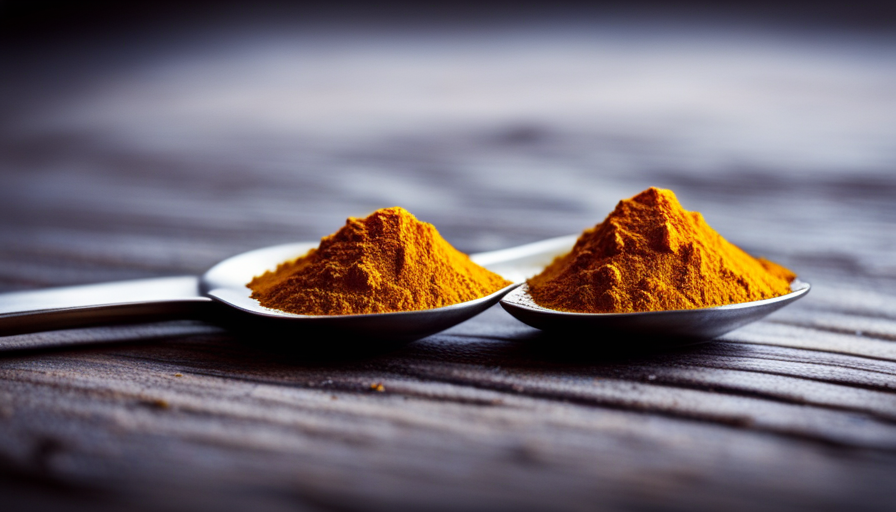I’ve always had a fondness for tea, yet lately, my fascination has shifted towards turmeric tea. Its flavor is absolutely delightful, and beyond that, it boasts an array of health advantages.
Turmeric is known for its anti-inflammatory properties, which can help ease joint pain and reduce inflammation throughout the body. It’s also packed with antioxidants and has been shown to improve brain function.
If you’re like me and want to incorporate more turmeric into your diet, making turmeric tea with turmeric powder is an easy and convenient way to do so.
In this article, I’ll walk you through step-by-step on how to make turmeric tea at home using just a few simple ingredients. Whether you’re looking for a warm beverage to sip on during cold winter nights or want to reap the health benefits of turmeric, this recipe is definitely worth trying out!
Key Takeaways
- Use high-quality turmeric powder and filtered/distilled water for best results.
- Adding ginger, cinnamon, and black pepper can enhance the flavor and benefits of turmeric tea.
- Simmering the tea for 10-15 minutes can improve the flavor and benefits.
- Consult a healthcare provider before adding turmeric tea to your diet, as it may interact with certain medications and have potential side effects.
Gather Your Ingredients
Ready to start making delicious turmeric tea? Let’s gather all the ingredients you’ll need!
Firstly, we need to get our hands on some high-quality turmeric powder. Turmeric is a bright yellow spice that’s been used in traditional medicine for centuries due to its many health benefits. It contains curcumin, which has anti-inflammatory and antioxidant properties, making it a great addition to your daily routine.
Next up, we need water. Make sure you use filtered or distilled water if possible, as tap water can contain impurities that may affect the taste of your tea. You’ll need about 2 cups of water for every 1 teaspoon of turmeric powder. If you like your tea stronger or weaker than this ratio suggests, feel free to adjust accordingly.
Now that we have our ingredients ready, let’s talk about the different types of turmeric tea you can make. Some people prefer adding honey or lemon juice for flavor, while others add ginger or cinnamon for an extra kick. There are also variations with coconut milk or black pepper added for enhanced absorption of curcumin in the body.
Once you’ve decided on your preferred type of tea and gathered all the necessary ingredients, it’s time to heat up the water!
Let’s move on to heating up the water without delay!
Heat the Water
So now that I’ve gathered my ingredients, it’s time to heat the water.
I like to bring a pot of water to a boil on the stove, then reduce the heat to let it simmer for a few minutes.
This allows the water to reach the perfect temperature for steeping the turmeric tea.
Boil the Water
First, fill a pot with water and bring it to a boil on the stove. Boiling water is essential in making tea as it helps release the flavors and compounds from the ingredients. Drinking boiled water also has benefits, such as killing bacteria and viruses, improving digestion, and promoting hydration. Once the water starts boiling, turn off the heat.
Now that you’ve boiled your water, you can proceed to add turmeric powder to make turmeric tea or any other tea of your choice. There are several types of teas that you can make using boiling water, like green tea, black tea, or herbal teas.
In the next section, we’ll discuss how to reduce the heat and prepare your turmeric tea perfectly.
Reduce the Heat
Now, you’ll want to lower the heat on your stove to a simmer and let the water cool down slightly before adding any additional ingredients for flavor. This step is crucial, as it allows the water temperature to drop from boiling point. Boiling water can destroy some of the active compounds in turmeric, reducing its health benefits.
By reducing the heat and allowing it to cool slightly, you ensure that your tea will have maximum potency. Reducing the heat also gives you an opportunity to adjust the flavor of your turmeric tea according to your preference. Some people find turmeric’s earthy taste too strong, while others love it.
Lowering the heat allows you more control over how much of that flavor gets infused into your tea. Once you’ve let it simmer for a few minutes and adjusted for taste if necessary, it’s time to add the turmeric powder!
Add the Turmeric Powder
Now that the water’s heated, it’s time to add the turmeric powder.
How much should you put in? Personally, I like to use about a teaspoon for every cup of water.
Once you’ve added the turmeric powder, don’t forget to give it a good stir to combine everything together.
This will ensure that the flavor and health benefits are evenly distributed throughout your tea.
How Much to Add
To achieve the perfect balance of flavor and health benefits, you should add a teaspoon of turmeric powder to your cup of hot water when making turmeric tea. This is the standard measurement for one cup of tea, but you can always adjust it according to your personal preference.
If you want a stronger or more potent tea, then adding more turmeric powder may be necessary. However, keep in mind that adding too much may result in an overpowering taste and could potentially cause stomach discomfort.
Aside from its unique flavor profile, turmeric also offers numerous health benefits. It contains curcumin, which is known for its anti-inflammatory properties and ability to boost the immune system. Additionally, studies have shown that drinking turmeric tea regularly may help improve digestion and reduce the risk of chronic diseases such as heart disease and diabetes.
By adding just a teaspoon of this golden spice to your daily routine, you can reap all these amazing benefits while enjoying a delicious cup of tea.
Now let’s move on to stirring to combine all the ingredients together!
Stirring to Combine
Once you’ve added the right amount of turmeric, simply stir it into your hot water until all the ingredients are combined and enjoy the benefits of this spice that has been linked to reducing inflammation in up to 80% of people who suffer from arthritis. To ensure that your turmeric tea is well mixed, use a spoon or whisk to stir gently but consistently. You can also try different stirring techniques such as swirling, back-and-forth motions or figure-eight patterns to vary the intensity of flavor in each sip.
As you experiment with stirring techniques, be sure to keep track of what works best for you and how it affects the overall taste of your tea. For instance, if you want a milder flavor, try stirring slowly and steadily while letting the turmeric powder dissolve completely. If you prefer a stronger taste, mix vigorously and let some clumps form for an extra kick. Whatever method you choose, remember that adding other flavors like honey or lemon can also enhance your turmeric tea experience.
Optional Add-Ins
Now that we’ve covered how to make turmeric tea with turmeric powder, let’s talk about optional add-ins that can enhance both the flavor and health benefits of your tea.
Personally, I like adding ginger for its anti-inflammatory properties and spicy kick.
Cinnamon is another great option as it has been shown to improve blood sugar control and may have anti-cancer effects.
Finally, black pepper contains a compound called piperine which can increase the absorption of curcumin, the active ingredient in turmeric, by up to 2000%.
Adding these ingredients can take your turmeric tea to the next level!
Ginger
Adding ginger to your turmeric tea will give it a spicy kick and enhance its immune-boosting properties. Ginger has been used for centuries as a natural remedy for various ailments, including nausea, inflammation, and colds. When combined with turmeric, which also has anti-inflammatory properties, the two create a powerful duo that can help boost your immune system and reduce inflammation in the body.
To make ginger turmeric tea, simply follow the recipe for basic turmeric tea and add fresh or ground ginger to taste. You can also experiment with different variations of this recipe by adding other ingredients such as honey or lemon. The benefits of ginger in tea are numerous, so incorporating it into your daily routine can be a great way to boost your overall health and wellness.
Now let’s move on to another optional add-in: cinnamon.
Cinnamon
You can enhance the flavor and health benefits of your turmeric tea by sprinkling a pinch of cinnamon into it. Cinnamon is known for its anti-inflammatory properties, just like turmeric. The combination of these two spices increases their potency and makes the tea even more beneficial for your health.
Aside from its numerous health benefits, cinnamon also has a sweet, warm flavor that complements the earthiness of turmeric. If you don’t have cinnamon on hand or want to try something different, some substitutes you can use are nutmeg or cardamom. These spices have similar flavors to cinnamon and will add an extra dimension to your turmeric tea.
Now that we’ve talked about cinnamon, let’s move on to another important ingredient: black pepper.
Black Pepper
If you’re looking to spice up your turmeric drink, try adding a pinch of black pepper – it may sound strange, but it’s worth it for the added health benefits and zing!
Here are three reasons why:
-
Turmeric and digestion: Turmeric has long been known for its anti-inflammatory properties. When combined with black pepper, the bioavailability of curcumin (the active compound in turmeric) increases significantly, which can help alleviate digestive issues such as bloating and gas.
-
Black pepper and immune system: Black pepper contains piperine, a compound that has been shown to enhance the immune system by increasing white blood cell activity. This is important because white blood cells play a crucial role in fighting off infections and diseases.
-
Improved taste: Let’s not forget about taste! Adding black pepper to your turmeric tea gives it an extra kick, making it more enjoyable to drink.
Now that we’ve talked about the benefits of adding black pepper to your turmeric tea, let’s move onto simmering and steeping for optimal flavor and health benefits.
Simmer and Steep
Now it’s time to let the flavors meld together as you simmer and steep your turmeric tea. Simmering is an essential step in making turmeric tea, as it helps release the flavor compounds from turmeric powder. By simmering your tea for about 10-15 minutes, you not only get a more concentrated flavor but also enhance its health benefits.
Aside from simmering, there are different steeping techniques that you can try depending on what suits your preference. You can use a teapot or infuser to steep your turmeric tea for around 5-7 minutes. Alternatively, you can also use the traditional method of boiling water and adding the powdered ingredients directly into it before letting it cool down to drinking temperature.
Once you’re done simmering and steeping your turmeric tea, it’s time to strain and serve. Straining helps remove any leftover powder particles or impurities in the liquid, giving you a smooth texture and clean taste. You can use a fine mesh strainer or cheesecloth to do this easily.
Serve hot with honey or lemon for added flavor and enjoy!
Strain and Serve
Now that the turmeric has simmered and steeped, it’s time to strain and serve.
To strain the tea, I use a fine mesh strainer to catch any small bits of turmeric powder or ginger that may have escaped earlier.
Once strained, the tea can be served hot or cold depending on personal preference.
Using a Fine Mesh Strainer
First, grab a fine mesh strainer to ensure your turmeric tea is free of any clumps or lumps. While there are other strainer alternatives, such as cheesecloth or coffee filters, using a fine mesh strainer is the best option for making sure your tea is smooth and enjoyable to drink.
Using turmeric powder in tea not only adds flavor but also provides many health benefits. Turmeric has anti-inflammatory properties that can help with joint pain and arthritis, as well as antioxidant properties that can improve brain function and lower the risk of heart disease. By using a fine mesh strainer to remove any clumps from your turmeric tea, you can fully enjoy all of these benefits in every sip.
Now that we have strained our tea, let’s move on to serving it hot or cold.
Serving Hot or Cold
Whether you prefer your turmeric-infused beverage piping hot or refreshingly chilled, there are a variety of ways to enjoy this healthful elixir. Here are some things to consider when deciding whether to serve it hot or cold:
-
Hot vs Cold: Turmeric tea is traditionally served hot, and many people find that the warmth helps soothe sore throats and calm upset stomachs. However, serving it cold can be a refreshing way to cool off on a hot day.
-
Benefits: Drinking turmeric tea has been linked to numerous health benefits, including reduced inflammation, improved digestion, and lower risk of chronic diseases like cancer and heart disease.
-
Risks: While turmeric tea is generally safe for most people to consume in moderation, there are some potential risks associated with consuming too much. For example, high doses of turmeric may interact with certain medications or cause gastrointestinal issues like nausea or diarrhea.
-
Flavor: The flavor of turmeric can be quite strong and earthy, which some people love and others find overwhelming. Serving it hot may help mellow out the flavor slightly by releasing more of its aromatic compounds.
-
Preparation time: If you’re short on time but still want to enjoy the benefits of turmeric tea, serving it cold might be your best bet. Simply mix up a batch ahead of time and keep it in the fridge for whenever you need a quick pick-me-up.
Now that we’ve covered some considerations for serving turmeric tea either hot or cold, let’s dive into the many health benefits this drink has to offer!
Health Benefits of Turmeric Tea
Discover the amazing health benefits of turmeric tea and start incorporating it into your daily routine. Turmeric, a bright yellow spice commonly used in Indian cuisine, has been shown to have powerful anti-inflammatory and antioxidant properties. By drinking turmeric tea regularly, you can experience its numerous health benefits, including improved brain function, reduced risk of heart disease and cancer, and better digestion.
To give you an idea of just how beneficial turmeric is for your health, here’s a table outlining some of its key components and their potential benefits:
| Component | Benefits |
|---|---|
| Curcumin | Powerful anti-inflammatory effects; may improve brain function and reduce risk of heart disease and cancer |
| Vitamin C | Boosts immune system; helps prevent infections |
| Iron | Essential mineral that helps transport oxygen throughout the body |
| Potassium | Helps regulate blood pressure; improves heart health |
| Manganese | Supports healthy bones; assists in wound healing |
Incorporating turmeric supplements or using turmeric powder in cooking are also great ways to reap the benefits of this miracle spice. However, drinking turmeric tea is an easy way to incorporate it into your daily routine without having to make any major dietary changes.
While there are many potential health benefits associated with drinking turmeric tea, it’s important to note that there may be some side effects as well. In the next section, we’ll discuss these potential side effects so you can make informed decisions about whether or not incorporating turmeric tea into your diet is right for you.
Potential Side Effects
Before I dive into the potential side effects of turmeric tea, it’s important to note that I’m not a medical professional and this information is for educational purposes only.
That being said, there are a few things to keep in mind if you’re considering adding turmeric tea to your routine. First, turmeric may interact with certain medications, so be sure to talk to your doctor before consuming it regularly.
Additionally, some people may experience allergic reactions such as skin rash or difficulty breathing after consuming turmeric.
Interactions with Medications
Warning: If you’re taking medications, be sure to talk to your doctor before adding turmeric tea made with turmeric powder to your diet as it could potentially interact with certain drugs. Turmeric contains compounds that may affect drug metabolism, absorption, and excretion. Therefore, it’s important to exercise caution when consuming turmeric tea alongside medication.
To help you better understand the possible interactions between turmeric and medications, I’ve created the following table outlining some of the most common drug interactions and dosage precautions associated with turmeric use. Please note that this is not an exhaustive list and that you should always consult your healthcare provider before making any changes to your medication regimen.
| Medication Type | Potential Interaction | Dosage Precautions |
|---|---|---|
| Blood Thinners (e.g., Warfarin) | May increase risk of bleeding or bruising | Avoid high doses of turmeric; Consult a healthcare provider before use |
| Diabetes Medications (e.g., Metformin) | May lower blood sugar levels too much | Monitor blood sugar levels closely; Consult a healthcare provider before use |
| Anti-inflammatory Drugs (e.g., Aspirin) | May increase risk of stomach irritation or bleeding | Use with caution; Consult a healthcare provider before use |
| Antibiotics (e.g., Ciprofloxacin) | May decrease effectiveness of antibiotics | Avoid concurrent use; Consult a healthcare provider before use |
It’s important to keep in mind that while these potential drug interactions exist, they do not necessarily occur in every individual who consumes turmeric. However, if you experience any unexpected side effects or changes in the effectiveness of your medication after consuming turmeric tea made with turmeric powder, be sure to contact your healthcare provider immediately. Next up we’ll discuss ‘allergic reactions’.
Allergic Reactions
Allergic reactions can occur when consuming turmeric, so it’s important to be aware of the symptoms and seek medical attention if necessary.
Some people may experience mild symptoms such as itching or hives, while others may have a more severe reaction that can lead to difficulty breathing or anaphylaxis.
It’s essential to know your body and pay attention to any changes you experience after consuming turmeric.
Prevention tips for allergic reactions include avoiding turmeric altogether if you’ve had a previous allergic reaction or are unsure of how your body will react.
If you’re considering adding turmeric to your diet, start with small amounts and gradually increase them over time.
Additionally, always read labels carefully and ask about ingredients when dining out.
Common symptoms of allergic reactions include itching, hives, swelling of the face or lips, difficulty breathing, and chest pain.
If you experience any of these symptoms after consuming turmeric tea or other products containing turmeric powder, seek medical attention immediately.
Frequently Asked Questions
How much turmeric powder should I use to make turmeric tea?
To make a delicious and healthy cup of turmeric tea, it’s important to know just how much turmeric powder to use. Turmeric tea benefits are numerous, as this spice has been shown to have potent anti-inflammatory and antioxidant properties.
When it comes to turmeric tea recipes, the amount of turmeric powder needed will depend on your personal taste preferences. However, a good rule of thumb is to start with 1 teaspoon of turmeric powder per cup of water. You can adjust the amount up or down depending on how strong you like your tea.
Just be sure to mix the turmeric powder well into the water before adding any other ingredients for maximum flavor and health benefits.
Can I use fresh turmeric instead of turmeric powder?
Yes, you can definitely use fresh turmeric instead of turmeric powder to make turmeric tea. In fact, using fresh turmeric has its own benefits as it contains higher levels of curcumin which is the active ingredient responsible for most of the health benefits associated with turmeric.
To use fresh turmeric, simply peel and grate a small piece (about an inch) into a pot of boiling water and let it simmer for about 10 minutes. You can also add other ingredients such as ginger, cinnamon, or honey to enhance the taste and boost its health benefits.
Overall, whether you use fresh or powdered turmeric, drinking a cup of turmeric tea daily is an excellent way to improve your overall health and wellbeing.
Can I add honey or sugar to sweeten the turmeric tea?
When it comes to turmeric tea, adding honey or sugar is a matter of personal preference. I personally like to add a tablespoon of raw honey to my turmeric tea for its added sweetness and antibacterial properties.
However, it’s important to note that too much added sugar can negate some of the health benefits of turmeric. If you’re looking for alternative sweeteners, stevia and monk fruit extract are both natural options that won’t spike your blood sugar levels.
When consumed regularly, turmeric tea with honey or other natural sweeteners can have anti-inflammatory effects on the body, helping to reduce joint pain and inflammation. Additionally, adding a touch of sweetness can make this healthy beverage more enjoyable to drink on a daily basis.
How long should I simmer and steep the turmeric tea?
When making turmeric tea with turmeric powder, it’s important to simmer the mixture for at least 10-15 minutes to fully extract the beneficial compounds from the root. During this time, you can add other ingredients like ginger or black pepper to enhance the flavor and increase absorption of curcumin, the active compound in turmeric.
After simmering, turn off the heat and let the tea steep for an additional 5-10 minutes before straining and serving. This allows the flavors to meld together and ensures that all of the nutrients are released into the water.
Overall, taking your time with both simmering duration and steeping time will result in a flavorful and nourishing cup of turmeric tea.
Can I drink turmeric tea every day?
Ah, the age-old question: can I drink turmeric tea every day? Well, let me answer that with a resounding ‘yes!’
Not only is turmeric known for its anti-inflammatory properties, but consuming it daily can have a range of benefits for your overall health.
From boosting immune function to improving brain function and reducing the risk of heart disease, this spicy little root has got it all.
And if you’re not a fan of sipping on tea all day long, fear not! There are plenty of alternative ways to consume turmeric for health benefits – try adding it to your morning smoothie or sprinkling it over roasted veggies for an extra kick.
So go forth and embrace the golden goodness that is turmeric!
Conclusion
Well, that’s it! Making turmeric tea with turmeric powder is easy and requires only a few simple steps. The key to getting the most out of this drink is to use good quality ingredients and let the tea simmer for a while. Don’t forget to add some honey or lemon juice if you prefer a sweeter taste.
In conclusion, adding turmeric tea to your daily routine can have numerous health benefits, such as reducing inflammation and lowering the risk of heart disease. However, as with any natural remedy, it’s important not to overdo it and be aware of potential side effects.
As the saying goes, ‘everything in moderation,’ so enjoy your cup of turmeric tea but don’t rely on it as a cure-all solution.










